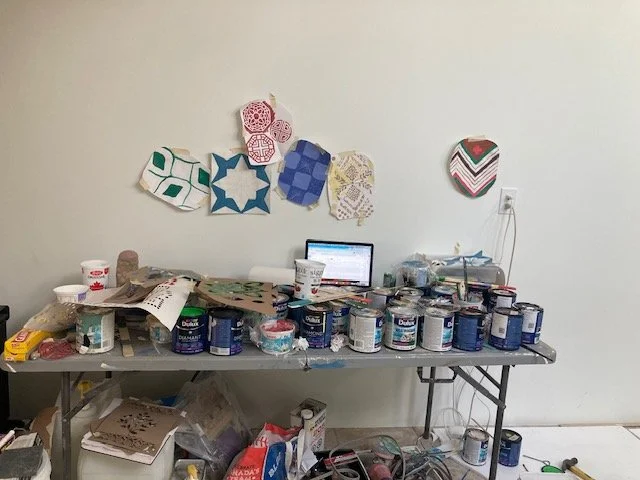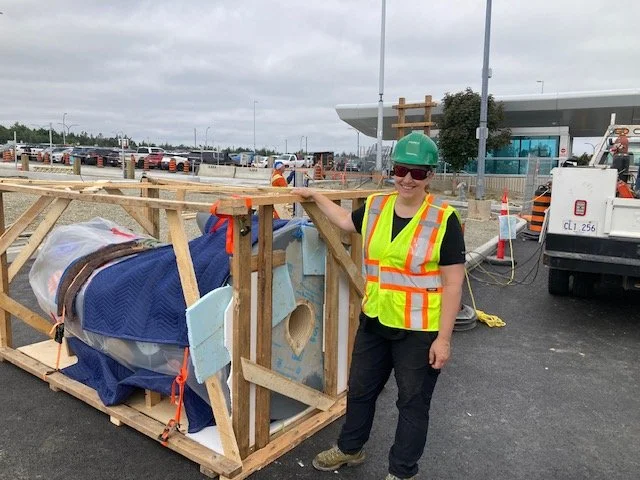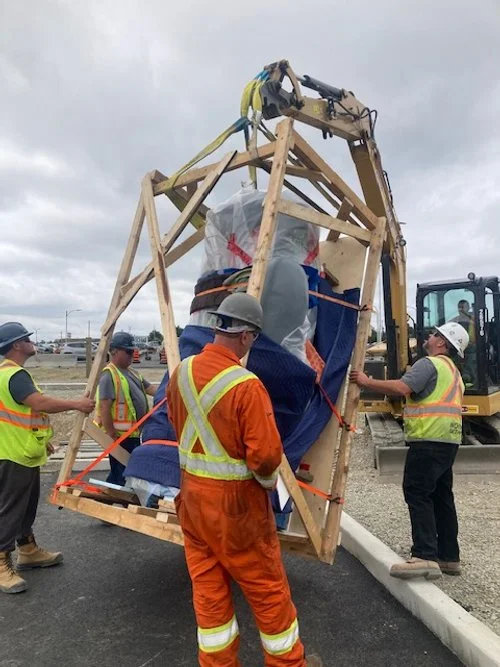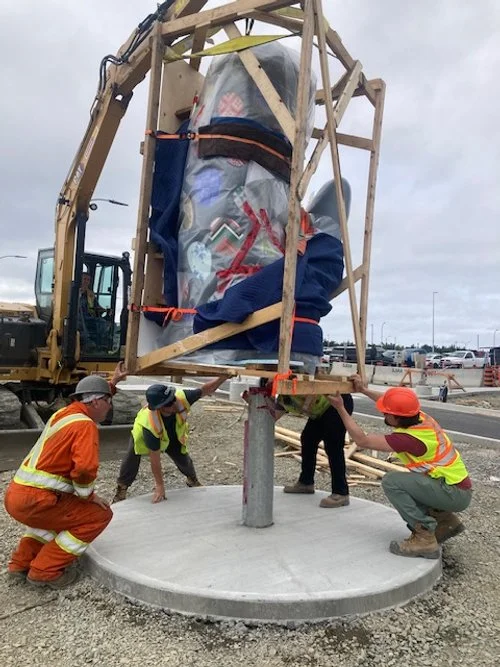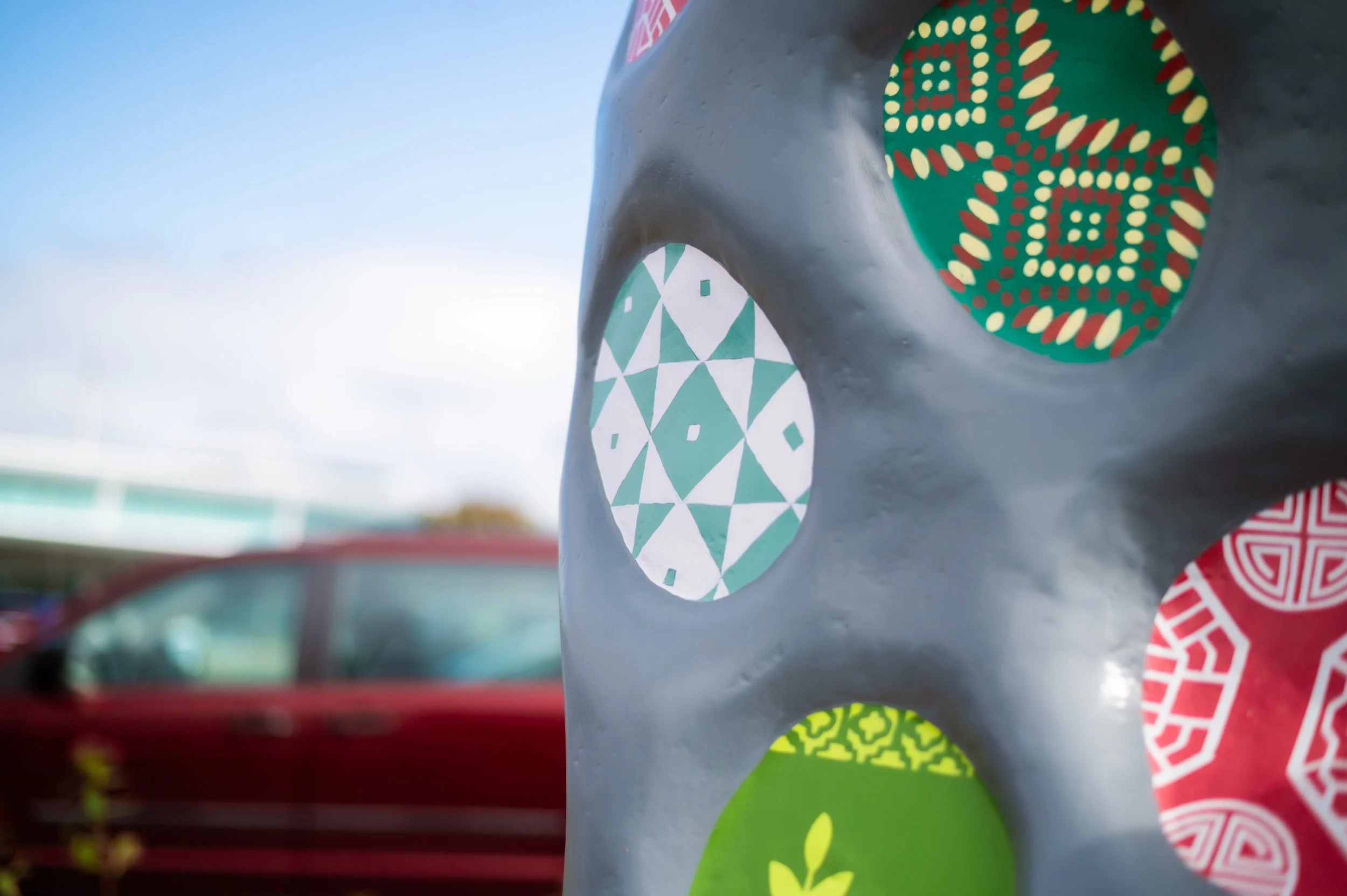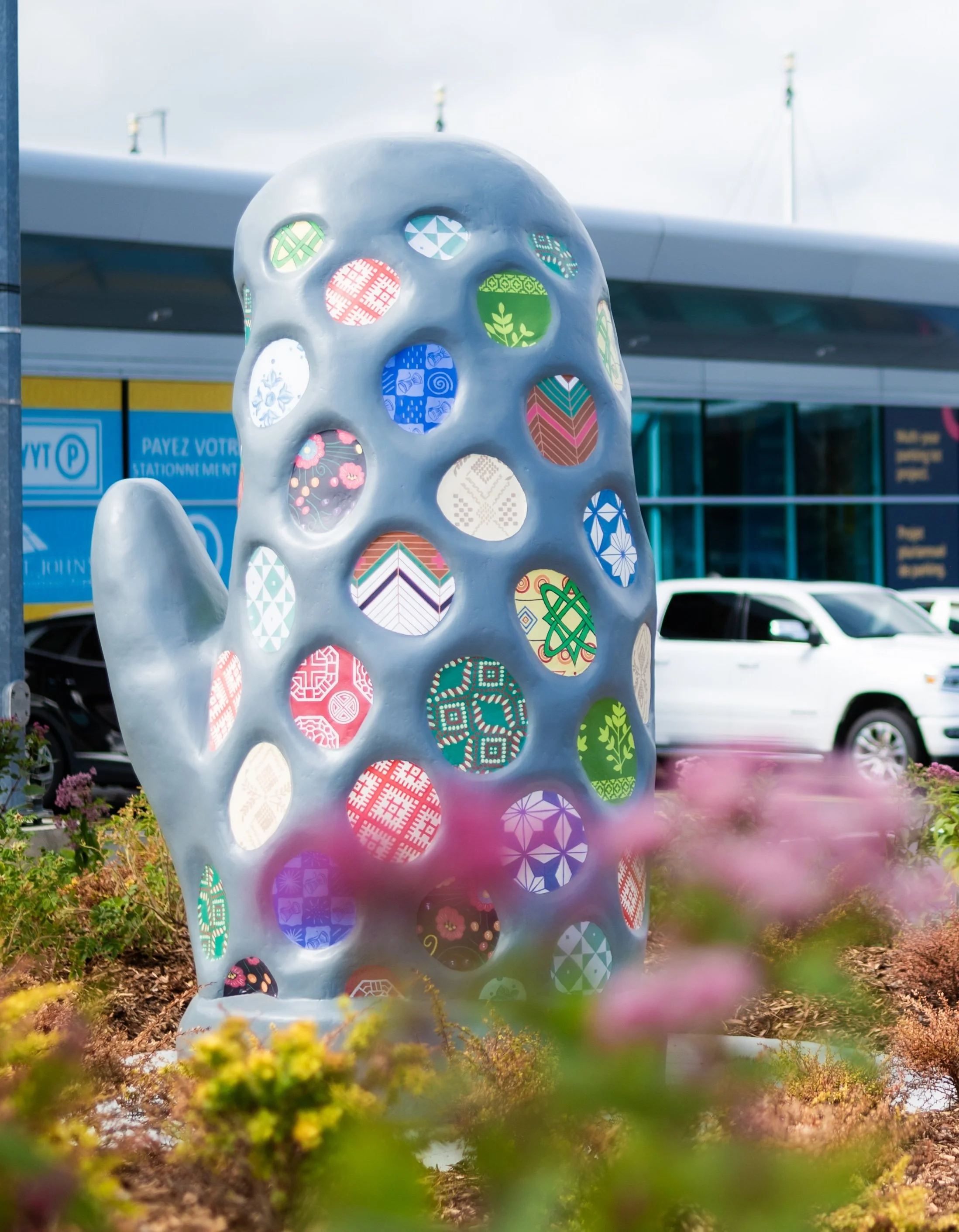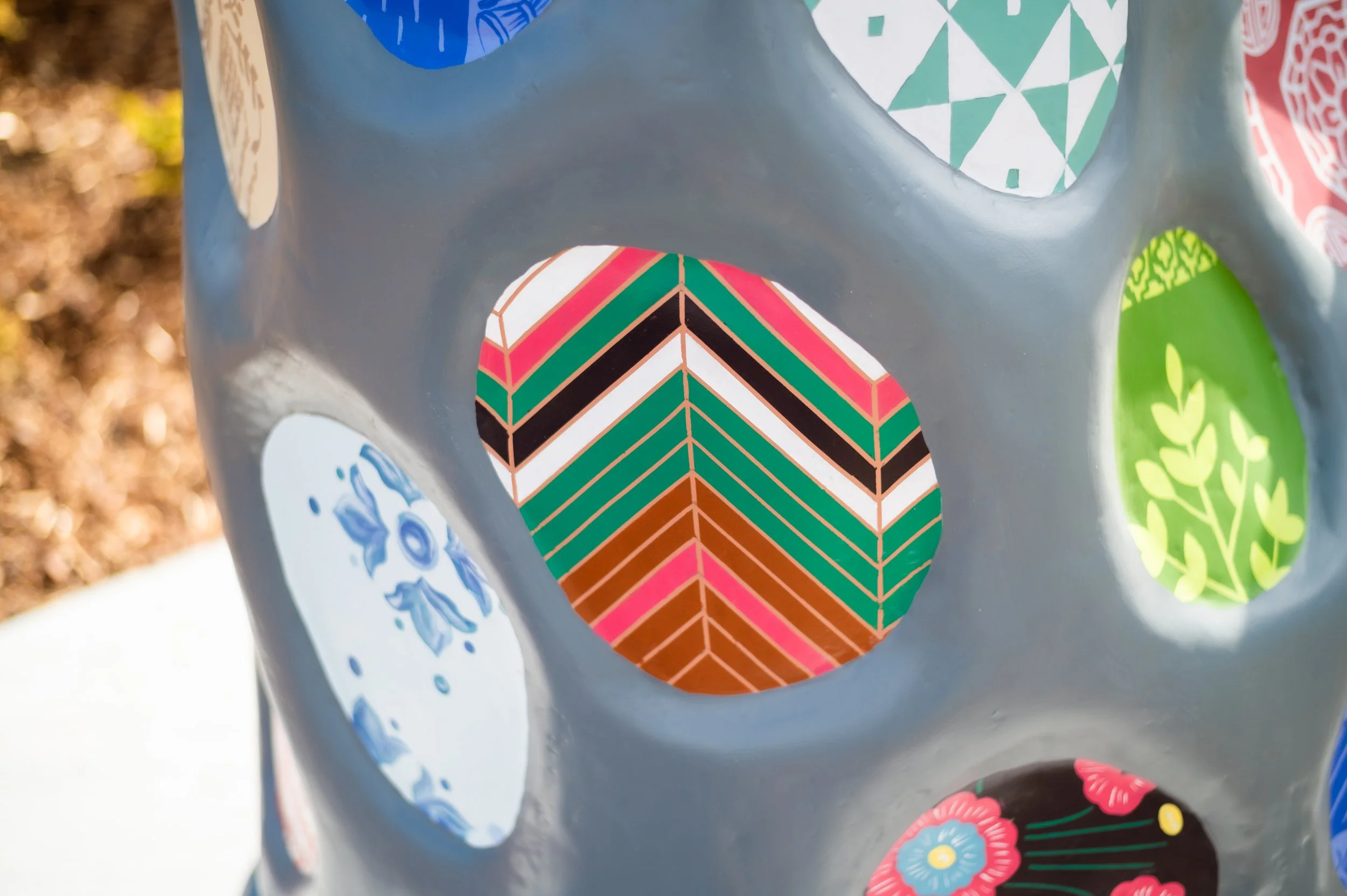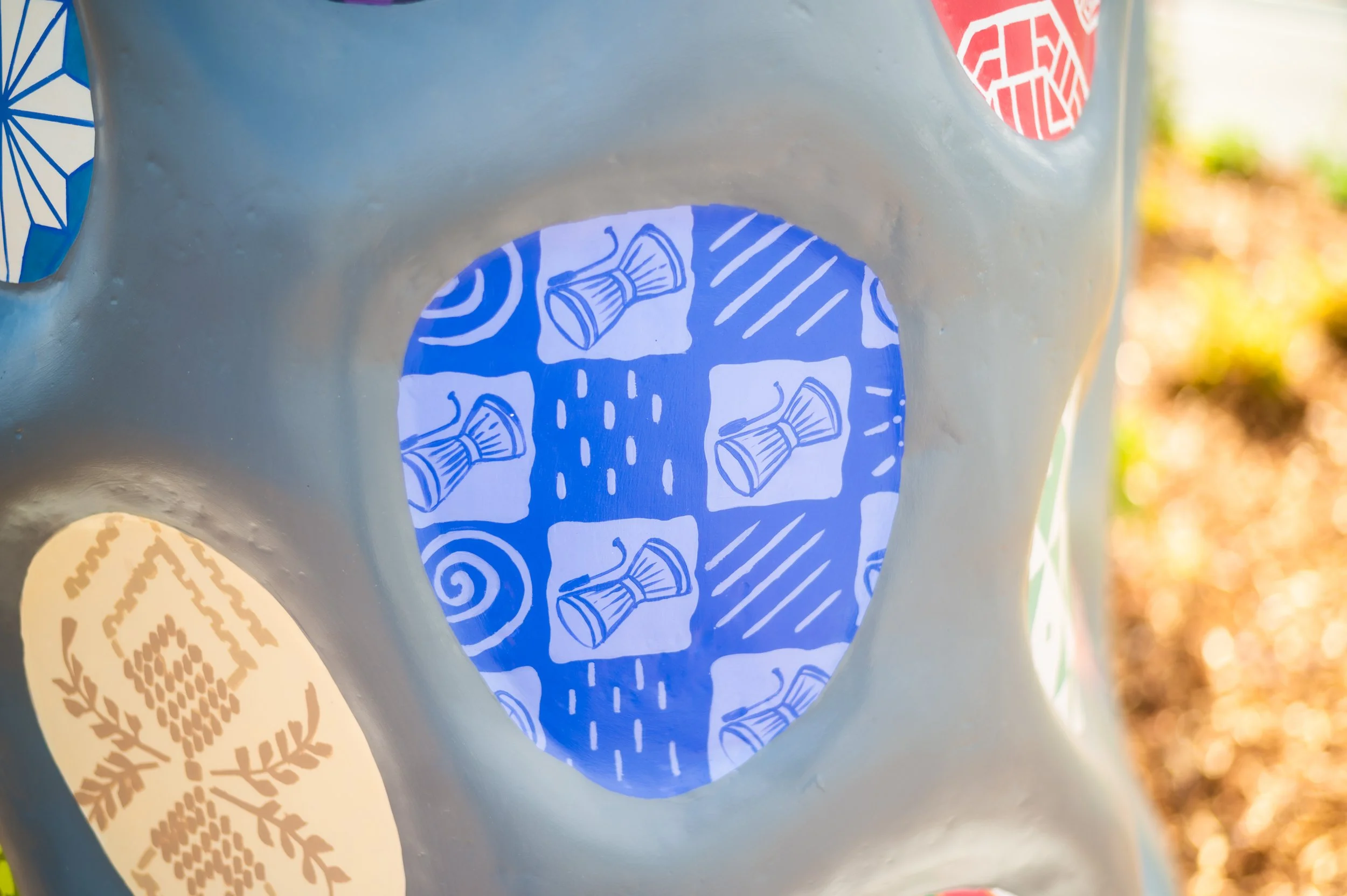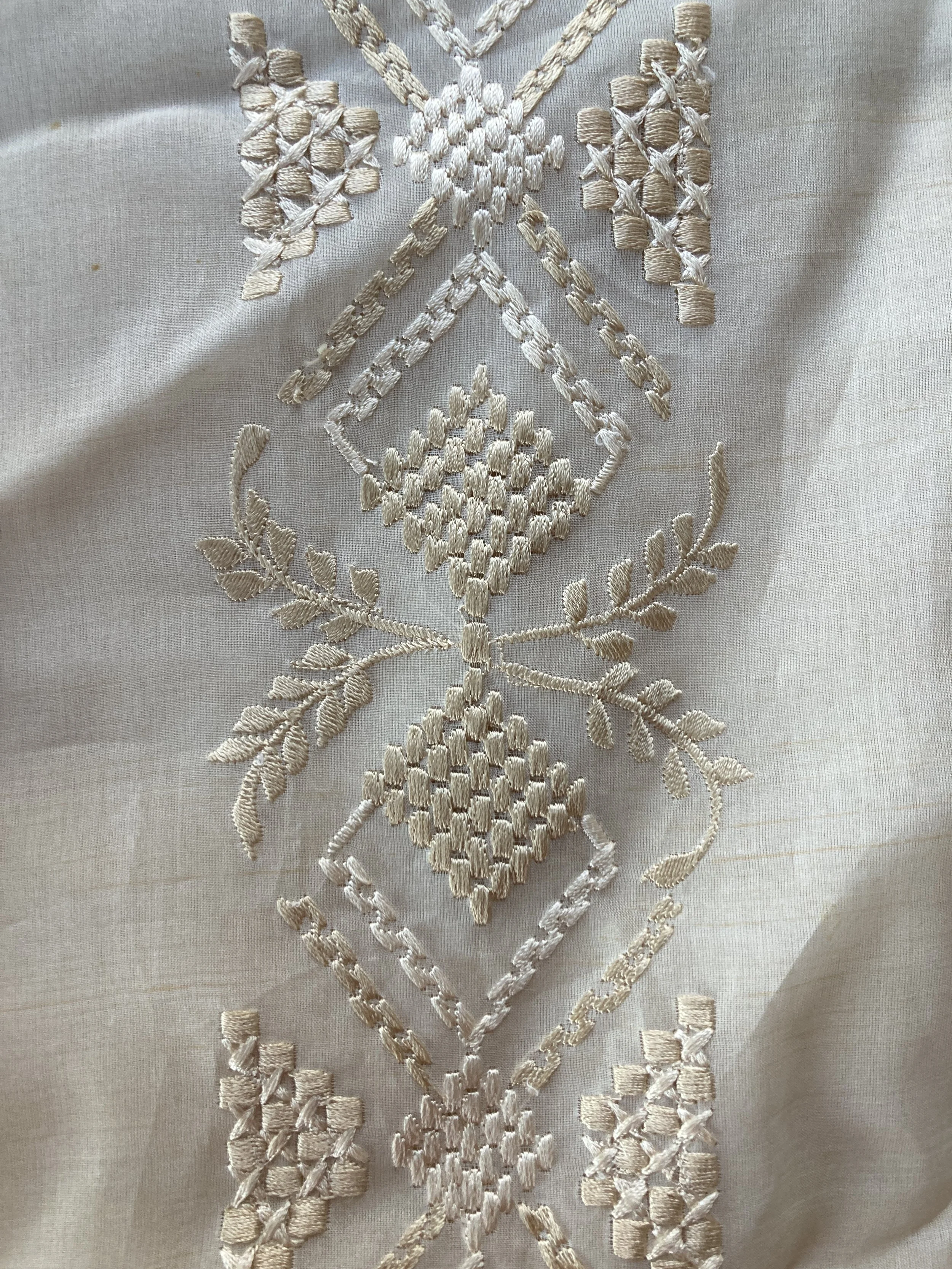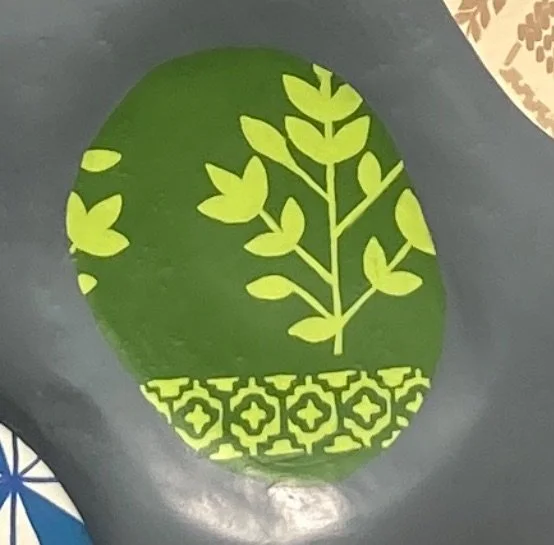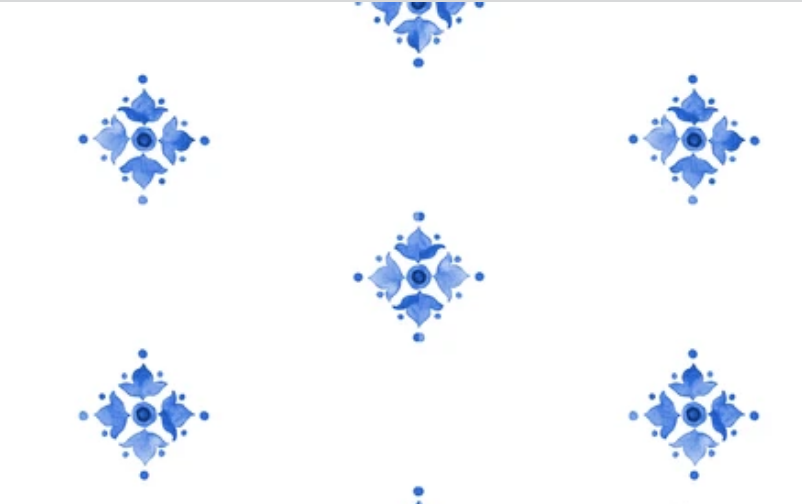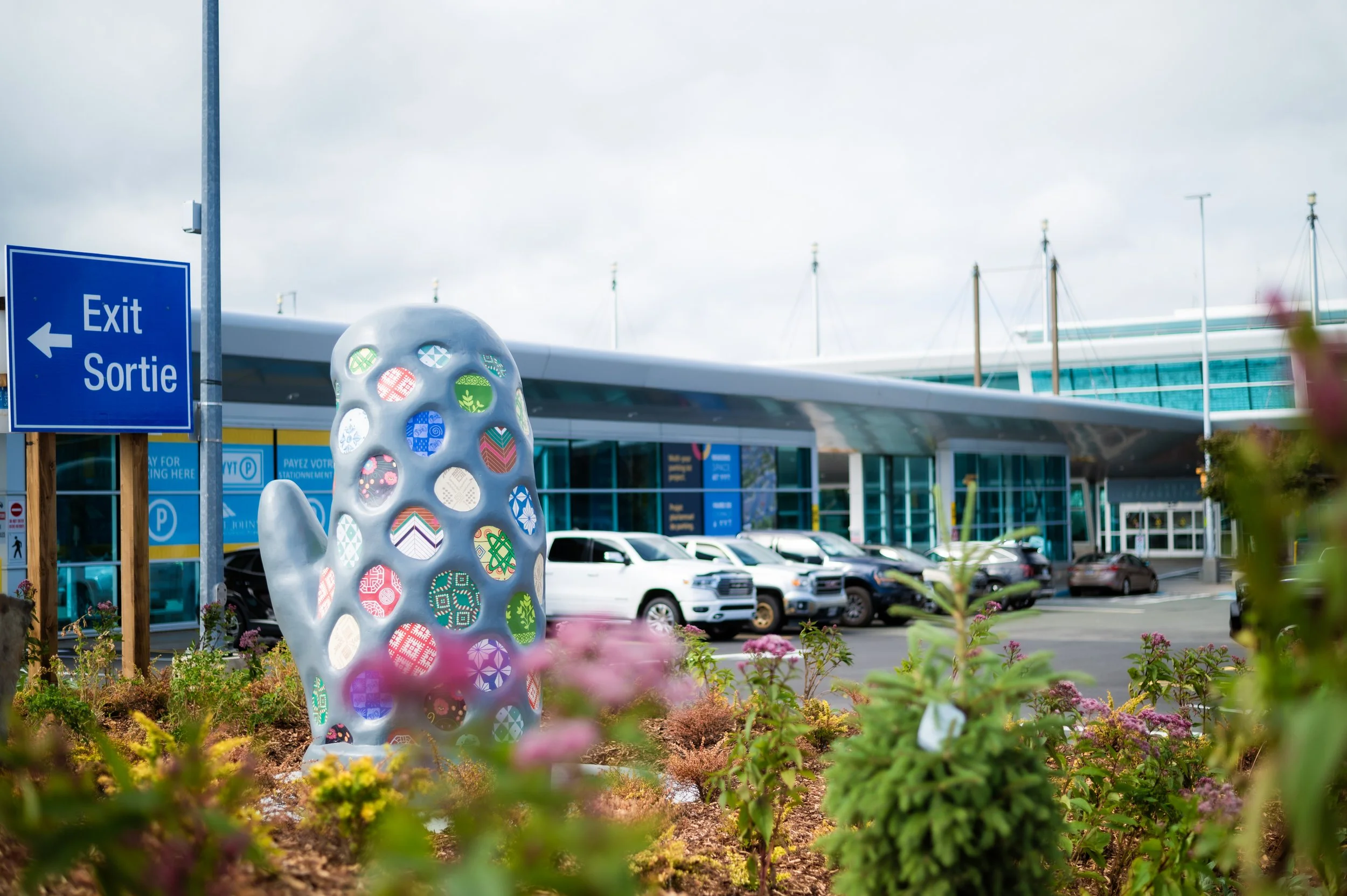
Marcia Huyer
Who Knit You
2025
Foam, fibreglass, epoxy, paint
Site 3 – Short Term Exit
Mittens in Newfoundland are particularly distinctive in their shape and patterns. A mitten is an understated, humble article of clothing signifying warmth and comfort. A knitted mitten carries the maker within it. The patterns on a mitten hold history, place, and stories. This friendly oversized mitten gestures a hello or goodbye to the airport’s visitors. Within the mitten are various textile patterns that represent diverse cultures that now call Newfoundland home.
Newfoundland’s original name, Ktaqmkuk, means “across the water”, which suggests to me that this place has a very long history of being connected to other places and people. The landscape of the island and influences from other cultures has formed a distinctive culture in Newfoundland.
Pattern Contributors
As this is a public sculpture that recognizes diverse cultures, the artist worked with the following NL-based collaborators to incorporate these designs:
-
The design is from the embroidery on the Barong Tagalog that was worn and outgrown by Mary Ann's youngest son. The Barong Tagalog is a formal, long-sleeved embroidered shirt and the national dress of the Philippines for men. It is worn in both informal and formal occasions such as weddings and national festivals. The Barong Tagalog combines pre-colonial Filipino and Spanish influences in its design and construction.
It is traditionally made from:
piña- a sheer fabric hand-woven from pineapple leaf fibers.
piña seda-It has a fine lustrous silk-like texture and has a natural yellowish tinge. a traditional fabric created by interweaving piña and silk (seda) fibers.
Jusi – a traditional sheer fabric hand-woven from abaca fibers. It has a polished texture and a natural off-white color.
-
Kerenhappuch Gandu is a Nigerian-born multimedia artist and a BFA graduate from the MUN Grenfell Campus. Her work draws inspiration from the exploration of personal and societal identity, highlighting the imperfections of humanity, the undefinability of beauty, and its acceptance. Additionally, it explores the significance of culture and its role in society.
The design is inspired by the Hausa architectural designs on mud houses in Northern Nigeria. These intricate designs, carved from mud houses and painted in vibrant colours, hold symbolic importance based on their complexity and the location or home they represent. Over the years, the motifs have moved from mud walls to textile designs used on traditional mats, pillows and ceremonial wears. Centuries of these designs have been an integral part of Northern Nigeria, fostering a sense of unity and belonging among its people
-
The symbols used on the mitten have had many variations over the course of five thousand years of Korean history. These symbols are often seen in traditional Korean clothes, furniture, art pieces, buildings such as temples or homes of high officials.
The smaller symbols used represent prosperity. The symbol with the flower shape may represent a lotus flower that symbolizes purity and enlightenment from Korean Buddhism. Known to produce beautiful flowers in muddy water, it signifies the possibility of transition to a better life.
-
The design is inspired by the Yoruba "Adire" fabric/ patterns and the main motif is the Yoruba talking drum or "ilu bata" These drums have been in the Yoruba culture for a long time and continue to play a significant role in various religious and social events. And the other motifs around are my attempt to visualise some of the sounds that the drums make.
-
In collaboration with Marcia Huyer.
The design is based on the Tulsi plant also known as holy basil, Holy basil is native to the Indian subcontinent and grows throughout Southeast Asia. The plant is widely used in Ayurvedic and folk medicine, often as an herbal tea for a variety of ailments, and is considered sacred in Hinduism.
-
This digital design was inspired by the patterns and colours found in Mi’kmaw quillwork boxes, which are most often crafted using birchbark, wood, porcupine quills, and aniline dyes. I wanted to carry the feeling of those traditional materials into a digital space. The colours I used are also a little nod to my grandmother—she had a few favourite colours she used all the time in her quilting, and they found their way in here too. It’s a blend of old and new, family and tradition.
About Kelsey
Kelsey Street is a L’nu artist from the west coast of Ktaqmkuk (Newfoundland). Corner Brook has always been home for her—she was raised there and still lives in the community, with family roots in nearby Benoit’s Cove/Woods Island and deep ties to the Elmastukwek (Bay of Islands) area. Street has a multidisciplinary practice — often centred around collaboration — working across sculptural beadwork, printmaking, textiles, digital design, and site-specific performance and installation. Her work often explores themes of community, resettlement, intergenerational memory, and storytelling, grounded in connection to place and lived experience in her home territory.
-
In Tanzania and across East Africa, the kanga (kah-nga) is more than just a piece of clothing—it is a vibrant expression of identity, communication, and culture. Worn by women of all economic backgrounds, from rural farmers to urban professionals, the kanga is a democratic garment that transcends class, religion, and generation.
-
The four-pointed star in Iranian art, a prominent feature in geometric designs like those seen in the Sheikh Lotfollah Mosque in Isfahan, embodies a profound sense of balance and cosmic order, reflecting the four elements—wind, fire, earth, and water—that are foundational to ancient Persian cosmology and philosophy. This star, often integrated into the mosque’s intricate tilework with its symmetrical diamond shapes, symbolizes the harmony of these elements, each representing a vital force: wind for movement and spirit, fire for energy and transformation, earth for stability and grounding, and water for life and purity.
By tiling this star, it would become part of a greater motif, a well-centered 4 pointed star (cross star).
To make another motif and meaning. It is enough to change the colour of one point of a whole 4 pointed star. It will evolve into a motif of the Iranian Mystical bird. (Simorq)
In Iranian art, the symbol of a bird is often associated with freedom and the journey to the divine or spiritual realm. This symbolism is deeply rooted in Persian culture and mysticism, where birds are seen as messengers between the earthly and heavenly worlds. In miniature paintings, poetry (such as the works of Rumi and Hafez), and architectural decorations, birds like the Homa or Simurgh represent spiritual ascension, enlightenment, and the soul's quest for liberation.
Then I tiled them (rotated and mirrored).
In Iranian culture, this star is associated with cosmic harmony, the eight gates of paradise in ancient Iranian tradition, and the idea of infinity due to its radial symmetry. Its eight points can also symbolize the balance of the material and spiritual worlds, as well as the four cardinal and four intermediate directions, reflecting a holistic view of the universe. Unlike the four-pointed star, which may connect to the four elements, the eight-pointed star often carries a more celestial and spiritual significance, emphasizing unity and the eternal.
-
The image used is a detail from the embroidery from the Vyshyvanka, a traditional Ukrainian embroidered shirt that is both a symbol of national identity and a deeply spiritual garment. The word “vyshyvanka” comes from the Ukrainian word vyshyvaty, meaning “to embroider.”
Each vyshyvanka is decorated with unique hand-stitched patterns made from colorful threads, often using symbols passed down through generations. These designs are more than decoration -they carry cultural meaning, regional identity, and even protective power. Historically, people believed that certain patterns could ward off evil spirits and bring good fortune.
Today, the vyshyvanka is worn on holidays, at weddings, and during national celebrations -especially on Vyshyvanka Day, held annually on the third Thursday of May. On this day, Ukrainians around the world proudly wear their embroidered shirts to celebrate their heritage and unity.
The vyshyvanka is not just clothing - it's a living art form, a connection to ancestors, and a beautiful expression of Ukrainian soul and identity.
-
The traditional embroidery of Acatlán, Guerrero, is a craft deeply rooted in the cultural identity
of the ñuu savi (Mixtec) people. These pieces, worked mainly by women, stand out for their
colorfulness and symbolic richness. The embroidered motifs - such as flowers, birds, fretwork
and everyday scenes - not only embellish the garments, but also tell stories, convey ancestral
knowledge and reflect the indigenous worldview.
The flowers represent fertility and connection to earth; the birds symbolize freedom and the link
between the earthly and spiritual worlds; and the fretwork evokes balance and the cycle of life.
Each stitch holds the time, patience and wisdom inherited from generation to generation. Thus,
Acatlan embroidery is not only an ornament, but a visual language that safeguards the collective
memory and cultural resistance of its community.
I created this Digital adaptation of traditional embroidery with deep respect. This design does not
belong to me or anyone else – it is a part of the rich cultural heritage of my home state in
Mexico, and I’m incredibly proud to share it.
-
My father immigrated to Canada as a child from South Holland, Netherlands. I grew up in a Dutch community in Ontario and was very influenced by this culture. Most traditional Dutch textiles are plain black clothing with lace details therefore I choose to use symbolism from their pottery. I chose to use this blue flower pattern with the well known Delft blue. Delft pottery was inspired by Chinese porcelain. The flower represents the blossoming in a new place.
-
This particular pattern is on a pair of trigger mittens that I have. I changed the colours to green and white on the sculpture. There are endless pattern and colour choices on Newfoundland mittens. I recommend reading Saltwater Mittens by Christine LeGrow and Shirley A. Scott.
About the Artist
Marcia Huyer is an artist currently living on the island of Ktaqmkuk/ Newfoundland in Corner Brook. Huyer’s work has been shown in festivals and public institutions across Canada. Past exhibitions include The Blue Building Gallery, Art Gallery of Greater Victoria, Victoria, BC; Eastern Edge, St.John’s, NL; Artcite Inc., Windsor, ON; ODD Gallery, Dawson City, YK. Huyer has participated in several art festivals such as Scotiabank’s Nuit Blanche, Toronto; CAFKA 07, CAFKA 18, Kitchener, ON; in/future Art Festival, Ontario Place, ON; and the Bonavista Biennale 2021, Bonavista, NL.


